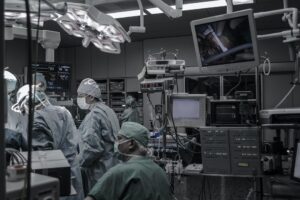 Springs are integral components in the manufacture of many medical devices. Whether it’s for a surgical stapler or a medical monitor, the types of springs in medical devices are defined by a specific action or movement required for the application. Though relatively simple in its design, springs store the mechanical energy necessary for a wide range of medical devices, machinery, and equipment to function properly.
Springs are integral components in the manufacture of many medical devices. Whether it’s for a surgical stapler or a medical monitor, the types of springs in medical devices are defined by a specific action or movement required for the application. Though relatively simple in its design, springs store the mechanical energy necessary for a wide range of medical devices, machinery, and equipment to function properly.
Any type of surgical instrument, medical equipment or device that has a mechanism undoubtedly has a spring component. Spring material must be medical grade, and the design and function of any device must adhere to stringent regulatory requirements and guidelines as defined by the FDA. Booms, table and bed lifts, fluid control devices, wheelchairs, medical testing and monitoring equipment either fixed or mobile, MRI and X-ray machinery, dental x-ray with articulated arms, medical equipment drawer closing mechanisms, anesthetic infusion devices, sterilization valves, various implants, and shunt valves are all examples of medical devices that require springs to function.
Manufacturers of medical equipment and devices then rely heavily on springs for a wide variety of applications. The type of springs that the medical industry relies on is the same that most industries rely on—the compression spring, tension spring, and torsion spring.
Compression Springs
The compression spring is by far the most common type of spring. The familiar helix coil gets its name from the way energy is stored and released when squeezed or compressed. Compression springs provide resistance or absorb force, which in turn creates the required energy to carry the load. They are used as shock absorbers, vibration-dampers, pure energy accumulators, or force generators. They are found in such noninvasive applications as diagnostic and monitoring equipment or in pill dispensers, inhalers and auto-injection syringes. Specialized compression springs as small as .030 mm for arterial widening can be implanted directly into a patient’s body. Compression springs are also used as components in surgical and nonsurgical devices as pacemakers, surgical staplers, and catheters.
Tension Springs
Also known as extension springs, these springs are designed to resist stretching and provide the necessary tension to pull two components back together when moved apart. Thus, tension springs generally consist of a hook or eye at either end that are attached to separate components. They can be used for cushioning or to automatically close an opening or keep two pieces of an object together. Medical equipment such as stretchers and surgical lights and a range of handheld medical devices utilized tension springs.
Torsion Springs
These springs are designed to function with torque, i.e., a twisting action or rotational movement. The rotational movement is often used when a bending action is required. Think clothespins or garage doors. X-ray machines and MRI’s are common types of medical equipment that uses torsion springs. They are generally found in applications that require less than 360 degrees of rotation, but also may be used to obtain a large amount of torque through a small amount of rotation. A spiral torsion spring is designed to rotate in two directions with a “return to center” capability, such as in a dental X-ray head unit.
Springs are an essential component used in a wide array of medical equipment and devices. Even as healthcare technology becomes increasingly advanced, the use of compression, tension and torsion springs continue to play an important role in the design and manufacture of medical devices. Selecting the right one can ensure a medical device, instrument, or particular equipment’s success. Whether for use in noninvasive applications, or as components in surgical and nonsurgical instruments or in equipment as diverse as x-ray machines, bed lift mechanisms, and drug infusers, springs provide the mechanical energy necessary for the device to function properly and as designed.
If you’re looking for custom springs or components for your specific application contact James Spring today! Our experience and state-of-the-art manufacturing capabilities allow us to provide fabricators, engineers, and design firms with the best spring at a price that is affordable.

